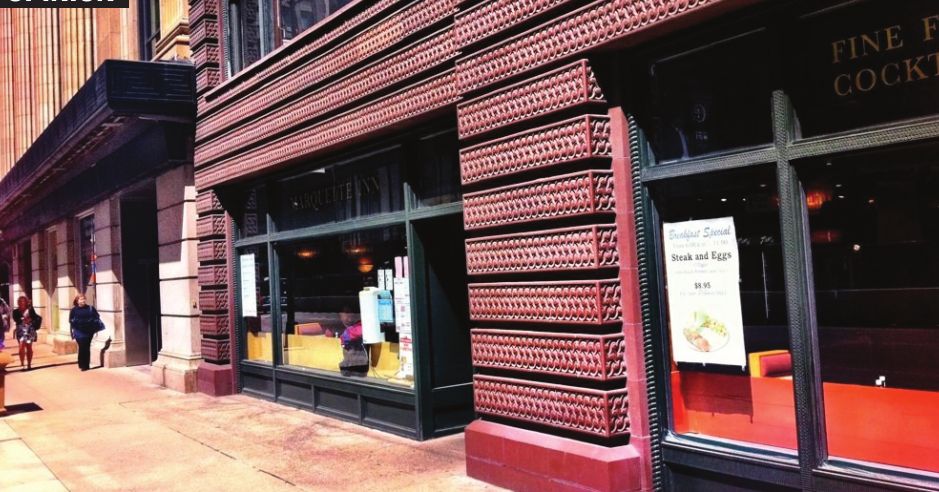
The classic American diner is dying
A few years ago, I met an old pal from Springfield in Chicago. We grabbed a bite at the Marquette Inn, the ground-floor diner named after the magnificent 1895 Loop building of that name which housed it, a place sentimental for both of us for different reasons. It was just as I remembered it – the owner with an unlit cigar between his teeth and a waitress who qualified for landmark status. (I halfexpected to see her sporting a bronze plaque instead of a name badge.) The difference was, we were practically the only people in the place.
I wasn’t surprised when it eventually closed.
Recently, I read that it had been replaced by The Marq, which offers “an ever-evolving, globally inspired menu of seasonal fare” that make for “a delicious, upscale, & easily approachable experience” which includes “everything you deserve.”
Christ. Call them diners, call them coffee shops, places like the old Marquette are my preferred eating establishments. The model is the many “American cafés” that one used to find all over Manhattan, whose owners are Greeks, whose cooks (these days) are Latino, and whose daily specials include falafel. (Tom’s Restaurant in Seinfeld is the exemplar.) Ed Levine, a Captain Cook of the Manhattan diner scene, recently spent three months, as he puts it, eating his way through New York’s diners. Levine concluded on Serious Eats that such emporia are “the greatest bastions of civility, service, and dare I say grace available to all economic strata in this country.” Amen.
People go to diners to eat, not to dine. They certainly don’t go for ever-evolving, globallyinspired menus of seasonal fare. This offends a lot of people, but to me, the best food is food you don’t remember, because if you did remember it, you probably wouldn’t come back, and then you’d have to find a new place. Besides, if the food’s good, the wrong kind of people start showing up.
Nor, I admit, does a sane man go to coffee shops for the coffee. Starbucks founders Baldwin, Siegl and Bowker deserve a Medal of Freedom for liberating America from Bunn- O-Matic coffee. But if you can get better food and coffee elsewhere, why go at all? Well, diners offer shelter from the street. They attract regulars, who reward attention. They also harbor characters, who often were the owners or the waitresses. (A few years ago, reminiscing of the Springfield Rewind web site, Clark Mefford recalled working at the South Town Grill (or “So. Town Grill,” as the sign over the doors had it) as a busboy. The owner was Chet Kwiatt; when he wanted his wife he would yell “Kwiatt please.”) And they are usually open. My father often worked late, and frequented 24-hour places like the Fleetwood (originally a truck stop on then-Route 66 bypass) and the Georgian, which closed as a restaurant in 1986 and was razed in 2005.
In his famous 1946 essay, “The Moon Under Water,” George Orwell imagined his ideal pub. His criteria are very close to the generally accepted criteria for a good diner or coffee shop. (Orwell: “The barmaids know the customers by name and take an interest in everyone.”) Levine offered his own criteria for the ideal diner, which I paraphrase thus: You can get pancakes for lunch or a grilled cheese for breakfast if you want. You can eat at the counter or in a booth. They attract regulars, who reward attention. They have cooks, not chefs. They’re like good bus service – quick service, cheap-ish, democratic. As Levine put it, “Diners offer the same warm and sassy welcome to everyone, regardless of socioeconomic status or ethnicity.” The last one I was at, a guy walked in wearing hot pants, a tight hot pink top, shaved legs and a wig; he was “Sweetie” like the rest of us.
Diners used to be ubiquitous in cities, but they’re disappearing quickly. Pop culture historians John Jakle and Keith Sculle writing in Fast Food: Roadside Restaurants in the Automobile Age, note the number of “lunchrooms/cafes/diners” in Springfield dropped from 118 in 1935 to 21 in 1995, and they are fewer now.
The casual dining chains that largely replaced them took from the classic diner their décor and their menus but not their ambience, mainly because the new ones were located not downtown but in the suburbanizing fringe where they became – I shudder to write this – “family restaurants.” Still the Denny’s and Howard Johnson’s and Tops Big Boys were better than nothing. “You don’t meet nice girls in coffee shops,” sings Tom Waits, but you can take one there. I did, to the Tops at 5th and South Grand in 1968, and I’ve been living with her ever since, which just goes to show you.
Contact James Krohe Jr. at [email protected].